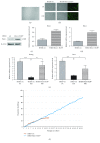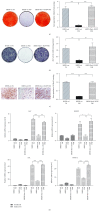Potential Research Tool of Stem Cells from Human Exfoliated Deciduous Teeth: Lentiviral Bmi-1 Immortalization with EGFP Marker - PubMed (original) (raw)
Potential Research Tool of Stem Cells from Human Exfoliated Deciduous Teeth: Lentiviral Bmi-1 Immortalization with EGFP Marker
Siqi Yao et al. Stem Cells Int. 2019.
Abstract
Stem cells from human exfoliated deciduous teeth (SHED) are a favourable source for tissue engineering, for its great proliferative capacity and the ease of collection. However, the transplantation of stem cells and the study of stem cell-based tissue engineering require massive stem cells. After long-term expansion, stem cells face many challenges, including limited lifespan, senescence, and loss of stemness. Therefore, a cell line capable of overcoming those problems should be built. In this study, we generated a Bmi-1-immortalized SHED cell line with an enhanced green fluorescent protein (EGFP) marker (SHED-Bmi1-EGFP) using lentiviral transduction. We compared this cell line with the original SHED for cell morphology under a microscope. The expression of Bmi-1 was detected with Western blot. Replicative lifespan determination and colony-forming efficiency assessment were using to assay proliferation capability. Senescence-associated _β_-galactosidase assay was performed to assay the senescence level of cells. Moreover, multipotency, karyotype, and tumour formation in nude mice of SHED and SHED-Bmi1-EGFP were also tested. Our results confirmed that Bmi-1 immortalization did not affect the main features of SHED. SHED-Bmi1-EGFP could be passaged for a long time and stably expressed EGFP. SHED-Bmi1-EGFP at a late passage showed low activity of _β_-galactosidase and similar multilineage differentiation as SHED at an early passage. The immortalized cells had no potential tumourigenicity ability in vivo. Moreover, we provided some suggestions for potential applications of the immortalized SHED cell line with the EGFP marker. Thus, the immortalized cell line we built can be used as a functional tool in the lab for long-term studies of SHED and stem cell-based regeneration.
Figures
Figure 1
Establishment and verification of the immortalized cell line SHED-Bmi1-EGFP from primary SHED. (a) Representative image of colonies formed after 3 d of isolation. Scale bar, 200 _μ_m. (b) Representative images of nontransfected original cells (SHED-ori) and SHED-Bmi1-EGFP with different passages. Scale bar, 200 _μ_m. (c) Protein level of Bmi-1 in SHED-ori P4 and SHED-Bmi1-EGFP P40 was detected by Western blot. The relative protein expression levels were normalized to _β_-actin. (d) Expression levels of Bmi-1 were assayed with qRT-PCR. (e) Expression levels of Nanog and Oct4 were assayed with qRT-PCR. (f) Population doublings (PDLs) of SHED-ori and SHED-Bmi1-EGFP. Data are shown as the mean ± SDs of 3 separate experiments. ∗ P < 0.05, ∗∗ P < 0.01, and ∗∗∗ P < 0.001.
Figure 2
Senescence level and proliferation capacity of SHED-ori and SHED-Bmi1-EGFP. (a) Blue cells were counted as a measure of senescence. Scale bar, 100 _μ_m. (b) SHED-ori were stained with _β_-gal at P4 and P20. SHED-Bmi1-EGFP were stained at P40. Blue cells were counted as a measure of senescence. Scale bar, 200 _μ_m. (c) Colony formation assay was performed to measure the proliferation capacity of SHED-ori P4, SHED-ori P20, and SHED-Bmi1-GFP P40.
Figure 3
Multilineage differentiation assay of SHED-ori P4, SHED-ori P20, and SHED-Bmi1-EGFP P40. (a) Alizarin Red staining was performed to evaluate the osteogenic differentiation ability of the cells, and the semiquantitative results were calculated. (b) ALP staining and ALP activity assays were performed both in SHED-ori P4, SHED-ori P20, and SHED-Bmi1-EGFP P40. (c) Adipose droplets in cells were stained orange by Oil Red O after 21 days of adipogenic differentiation induction, and the semiquantitative results were calculated. (d) Osteogenic and adipogenic differentiation related genes were detected by qRT-PCR. Scale bar, 200 _μ_m. Data are shown as the mean ± SDs of 3 separate experiments. ∗ P < 0.05, ∗∗ P < 0.01, and ∗∗∗ P < 0.001.
Figure 4
Assessment of potential tumourigenicity ability of SHED-Bmi1-EGFP. (a) Cytogenic analysis of immortalized cells. SHED-Bmi1-EGFP P40 showed no abnormality of karyotype. (b) Assessment of potential tumourigenicity of SHED-Bmi1-EGFP in vivo. In a total of 5 weeks after injections of cells into the left forelimb armpit, no tumour formation was seen in PBS, SHED-ori P4, or SHED-Bmi1-EGFP P40 group. (c) Tumour slides stained with haematoxylin and eosin dye. Positive control showed heteromorphism while PBS, SHED-ori P4, and SHED-Bmi1-EGFP P40 did not. Scale bar, 100 _μ_m.
Figure 5
Potential applications of SHED-Bmi1-EGFP. (a) SHED-Bmi1-EGFP were seeded in zein/gelatine scaffolds and were observed with a confocal microscope. Scale bar, 200 _μ_m. (b) SHED-Bmi1-EGFP were injected on the backs of nude mice, and EGFP signalling was detected by the Xenogen IVIS Spectrum.
Similar articles
- A novel method for banking stem cells from human exfoliated deciduous teeth: lentiviral TERT immortalization and phenotypical analysis.
Yin Z, Wang Q, Li Y, Wei H, Shi J, Li A. Yin Z, et al. Stem Cell Res Ther. 2016 Apr 4;7:50. doi: 10.1186/s13287-016-0309-0. Stem Cell Res Ther. 2016. PMID: 27044500 Free PMC article. - Enhancing Proliferation of Stem Cells from Human Exfoliated Deciduous Teeth (SHED) through hTERT Expression while Preserving Stemness and Multipotency.
Yadav P, Vats R, Wadhwa S, Bano A, Namdev R, Gupta M, Bhardwaj R. Yadav P, et al. Stem Cell Rev Rep. 2024 Oct;20(7):1902-1914. doi: 10.1007/s12015-024-10746-y. Epub 2024 Jun 15. Stem Cell Rev Rep. 2024. PMID: 38878252 - In vitro and in vivo characteristics of stem cells from human exfoliated deciduous teeth obtained by enzymatic disaggregation and outgrowth.
Jeon M, Song JS, Choi BJ, Choi HJ, Shin DM, Jung HS, Kim SO. Jeon M, et al. Arch Oral Biol. 2014 Oct;59(10):1013-23. doi: 10.1016/j.archoralbio.2014.06.002. Epub 2014 Jun 11. Arch Oral Biol. 2014. PMID: 24960116 - Stem Cells from Human Exfoliated Deciduous Teeth: A Growing Literature.
Martinez Saez D, Sasaki RT, Neves AD, da Silva MC. Martinez Saez D, et al. Cells Tissues Organs. 2016;202(5-6):269-280. doi: 10.1159/000447055. Epub 2016 Aug 20. Cells Tissues Organs. 2016. PMID: 27544531 Review. - [Clinical applications of stem cells from human exfoliated deciduous teeth in stem cell therapy].
Xiaoxia L, Jiaozi F, Shi Y, Yuming Z, Lihong G. Xiaoxia L, et al. Hua Xi Kou Qiang Yi Xue Za Zhi. 2017 Oct 1;35(5):533-537. doi: 10.7518/hxkq.2017.05.017. Hua Xi Kou Qiang Yi Xue Za Zhi. 2017. PMID: 29188652 Free PMC article. Review. Chinese.
Cited by
- Immortalized cell lines derived from dental/odontogenic tissue.
Zeng Y, Liu L, Huang D, Song D. Zeng Y, et al. Cell Tissue Res. 2023 Jul;393(1):1-15. doi: 10.1007/s00441-023-03767-5. Epub 2023 Apr 11. Cell Tissue Res. 2023. PMID: 37039940 Review. - Nodal Facilitates Differentiation of Fibroblasts to Cancer-Associated Fibroblasts that Support Tumor Growth in Melanoma and Colorectal Cancer.
Li Z, Zhang J, Zhou J, Lu L, Wang H, Zhang G, Wan G, Cai S, Du J. Li Z, et al. Cells. 2019 Jun 4;8(6):538. doi: 10.3390/cells8060538. Cells. 2019. PMID: 31167491 Free PMC article. - Comparison of the Angiogenic Ability between SHED and DPSC in a Mice Model with Critical Limb Ischemic.
Yong Z, Kuang G, Fengying S, Shoumei X, Duohong Z, Jiacai H, Xuyan T. Yong Z, et al. Tissue Eng Regen Med. 2022 Aug;19(4):861-870. doi: 10.1007/s13770-022-00452-6. Epub 2022 Apr 26. Tissue Eng Regen Med. 2022. PMID: 35474506 Free PMC article.
References
LinkOut - more resources
Full Text Sources
Miscellaneous




